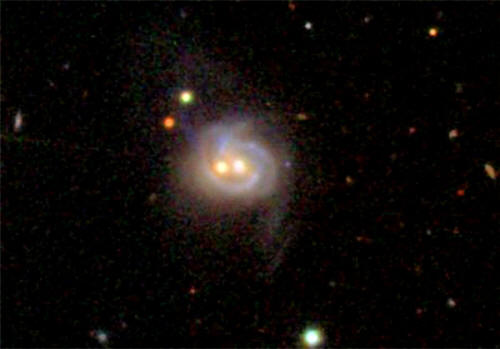|

by Stephen Smith
December 13, 2011
from
Thuntherbolts Website

Markarian 739 is
thought to be 425 million light-years away.
Its two bright
"nuclei" are clearly seen in this Sloan Digital Sky Survey image.
A remote galaxy is said to host two
black holes. Could an electrical explanation better fit the
observation?
Electric Universe advocates propose that electric currents in plasma
generate magnetic fields that constrict the current. As previous
Picture of the Day articles point out, the constricted channel is
known as a “Bennett
pinch,” or “z-pinch.” The
pinched electric filaments remain coherent over long distances,
spiraling around each other, and forming helical structures that can
transmit power through space.
Those strands of electric current and spiraling formations are seen
in almost every body in the Universe. Venus possesses a comet-like
tail that is “stringy,” as NASA scientists describe it.
Twin vortices of electric current are
also visible at Venus’ south pole - counterparts to the those
discovered at Venus’ north pole.
Comets, themselves, are often observed with twin tails, kinked
tails, “wiggly” tails, or multiple tails.
Comets manifestly
demonstrate the electrical nature of charged celestial objects.
Planetary nebulae are threaded through with strings and webs.
Glowing, braided filaments are sometimes visible in “jets” that
blast out from stars and some galaxies. The filaments are called
“Birkeland currents,” and they are the visible portion of enormous
electric circuits that form that large-scale structure of the
Universe. The circuits generate magnetic fields that can be mapped,
so their helical shape can be seen.
Plasma’s behavior is driven by conditions in those circuits.
Fluctuations in charge flow form double layers with enormous
voltages between them. This means that electric forces in double
layers can be several orders of magnitude stronger than gravity.
Double layers separate plasma into cells
and filaments that can have different temperatures or densities.
Various components coupled to and driven by electric circuits in
space comprise the heart of Electric Universe theory. Charged
particles accelerating through powerful electric fields radiate
energy in many bandwidths. Changing conditions within Birkeland
currents can alter the radiation patterns in some galaxies over
time.
According to a
recent press release, a “colliding”
pair of galaxies is creating a double-eye formation in Markarian
739. Since it is a foundational assumption of modern astrophysics
that over 90% of galaxies harbor Supermassive Black Holes (SMBH)
with gravity exceeding 100 million stellar masses, the conclusion is
logical from a conventional viewpoint.
They are detectable because vast clouds
of dust and gas are supposed to keep them “fed.”
However, the Electric Universe position
in these cases is that the image is a view “down the barrel” of a
Birkeland current filament pair spiraling down and concentrating
electrical energy.
The Bennett pinch regions are seen
end-on, where electricity flowing into them causes plasma to erupt
in a burst of radiation.
|

